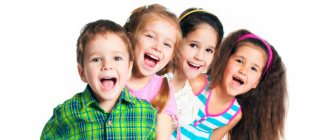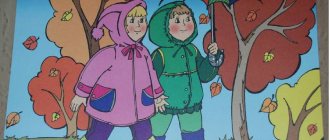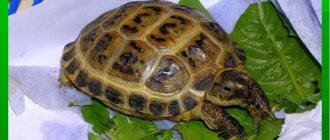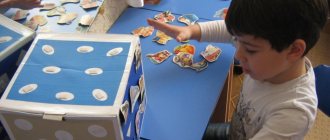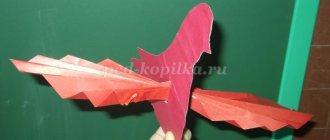Card file of autumn walks (senior group)
November.Card No. 5
1.Observation of rowan
Target:
consolidate knowledge about the benefits rowan brings to animals and birds in the cold season.
Progress of observation
So the first frost caught the rowan berries, they became tasty and soft. Animals and birds love rowan. A bear, if he finds it in the forest, hung with bunches of berries, will deftly tilt the flexible tree and enjoy its fruits with pleasure; The forest giants, elk, also like rowan berries. They reach the very top of the tree and eat fruits and branches with appetite. Berries that fall to the ground are picked up by voles, hedgehogs, chipmunks and squirrels. On pre-winter November days, flocks of bullfinches and waxwings arrive. They stick around the rowan and peck its juicy sweet berries. The birds peck quickly, dropping a lot of berries on the ground, then fly away further. Rowan saves many birds from hunger.
The crane's cry has already sounded, The garden has long since crumbled, And the bright clusters of rowan berries are still burning, hanging down.
2. “Sand cone” experiment.
Target:
show the property of sand - flowability.
Material: sand.
Procedure: Take a handful of dry sand and release it in a stream so that it falls in one place.
Gradually, a cone forms at the site of the fall, growing in height and occupying an increasingly larger area at the base. If you pour sand for a long time, first in one place, then in another, drifts occur; the movement of sand is similar to a current.
Conclusion: the property of sand is flowability.
3. Outdoor games
"Planes", "Sparrows and the Cat".
Target:
teach to quickly perform movements at the teacher’s signal and run in the indicated direction; cultivate friendliness.
4.Individual work
"Get in the basket."
Target:
develop accuracy and eye.
5. Didactic game
"Hide and Seek"
Target:
learn to find a tree by description, consolidate the ability to use prepositions in speech: behind, about, before, next to, because of, between, on; develop auditory attention.
6.Independent motor activity
November.
Card No. 5. Evening walk
1. Observation of migratory birds
Target:
expand ideas about migratory birds, about the changes in the life of birds in the fall, when cold weather sets in; foster love and care for birds.
The waters rustled like a fast stream, Birds flew away to warmer lands.
The teacher asks the children questions: What birds fly to warmer climes? Why are they doing that?
Birds gather in flocks and fly low above the ground. This means that they will soon fly away to warmer climes. Swallows will be the first to do this, since with the onset of cold weather the insects they catch in flight disappear. The last to fly away are ducks, geese, and cranes, as water bodies begin to freeze and they cannot find food in the water.
The teacher invites the children to complete the sentence:
• The sparrow is small, and the crane... (big).
• The duck is gray, and the swan... (white).
2. Didactic game “What kind of bird is this?”
Target:
clarify and expand ideas about bird life in autumn; describe birds by their characteristic features; cultivate a caring attitude towards birds.
Progress of the game:
Children are divided into 2 subgroups. Children of one subgroup describe the bird, and the other have to guess what kind of bird it is. You can use riddles. Then another subgroup asks their questions.
3. Word game “Do you remember these poems?”
Goal
: development of memory, attention, speech activity.
Progress of the game:
the teacher reads excerpts from poems familiar to the children. Children must pronounce the missing words.
Where did the sparrow have lunch? Don't stand too close:
At the zoo there are... (animals). I (tiger cub)
but not (…).
Wind across the sea (...)
And (...) customizes. Etc.
4. Outdoor game “Sparrows”. Target:
activation of the sound [h] in onomatopoeia;
development of dexterity. Progress of the game:
Children (sparrows) sit on a bench (in nests) and sleep. In response to the teacher’s words: “Sparrows live in a nest and everyone gets up early in the morning,” the children open their eyes and say loudly: “Tweet-chik-chik, chirp-chik-chik! They sing so joyfully."
After these words, the children scatter around the area. To the words of the teacher: “They flew to the nest!” - return to their places.
Labor activity:
Collecting pebbles on the site.
Target:
develop the ability to notice cleanliness in the area.
Organization and conduct of walks in the senior group of kindergarten
Experience as a preschool teacher.
Methodology for organizing and conducting walks in the senior group Relevance of the topic: Currently, the task of preserving and strengthening the health of children, both physical and mental, introducing them to a healthy lifestyle and mastering modern health-saving technologies is one of the most significant and priority ones. Most modern children rarely communicate with nature. do not come into contact with it, this deprives them of the opportunity to know and feel it not only with their eyes, but also with other senses. By communicating with nature, children could not only get psychological relief, but also get a positive emotional mood and improve their health. Nature is a rich storehouse, invaluable for the intellectual and speech development of a child. The goal is to improve health, prevent fatigue, physical and mental development of children, and restore the functional resources of the body that have been reduced during activity. Objectives: • to provide a hardening effect on the body in natural conditions; • help improve the level of physical fitness of preschool children; • optimize the motor activity of children and promote the cognitive, speech, artistic, aesthetic, social and personal development of children. Children's stay in the fresh air is of great importance for the physical development of a preschooler. Walking is the first and most accessible means of hardening a child’s body. It helps to increase its endurance and resistance to adverse environmental influences, especially colds. During the walk, children play and move a lot. Movement increases metabolism, blood circulation, gas exchange, and improves appetite. Children learn to overcome various obstacles, become more agile, dexterous, courageous, and resilient. They develop motor skills and abilities, strengthen the muscular system, and increase vitality. A walk promotes mental development, as children gain a lot of new impressions and knowledge about the world around them. Types of walks (at the venue): · on the site of the Institution; - walking walks outside the Institution site (senior preschool age at a distance of up to two kilometers); - in the functional premises of the kindergarten (on activated days). Types of walks by content: · Traditional, which includes children’s work activities (cleaning up leaves, snow, etc.), active and quiet games, etc.;; · Thematic: consisting of observations and conversations on a specific topic (animals, clouds, trees, city transport, etc.), can be a street theater performance, a quest with overcoming simple obstacles - requires a pre-prepared script; · Targeted (conducted from the second junior group with access beyond the kindergarten); · Excursion (conducted systematically from the middle group at least once a month); · Hiking, hiking (carried out with children of senior preschool age 1-2 times a year). The duration of walks on the street The daily routine of the kindergarten provides for a daily daytime walk after classes and an evening walk after afternoon tea. The time allotted for walking must be strictly observed. Its total duration is 4 - 4.5 hours. To achieve a healing effect in the summer, the daily routine provides for children to spend maximum time in the fresh air with breaks for meals and sleep. During the winter period, outdoor walks are carried out 2 times a day: in the first half of the day - before lunch, in the second half of the day - before the children go home. In order to prevent hypothermia of body parts (face, arms, legs) in cold weather, it is recommended to send children to a heated vestibule for heating for no more than 5-7 minutes. Winter walks in kindergarten for children under 4 years old are held at temperatures down to -15°C, for children 5-7 years old at temperatures down to -20°C. -The time for each age group to go for a walk is determined by the mode of education and training. Walking is prohibited due to wind force exceeding 15 m/s. Walk structure: 1. Observation. 2. Outdoor games: 2-3 games of high mobility, 2-3 games of low and medium mobility, games of children’s choice, didactic games. 3. Individual work with children on the development of movements and physical qualities. 4. Children's labor on the site. 5. Independent play activity. The sequence of structural components of a walk may vary depending on the type of previous activity. If the children were in an activity that required increased cognitive activity and mental stress, then at the beginning of the walk it is advisable to conduct outdoor games, jogging, and then observations. If there was a physical education or music lesson before the walk, the walk begins with observation or quiet play. Each of the required components of the walk lasts from 7 to 15 minutes and is carried out against the background of independent activity. Observation A large place on walks is given to observations (pre-planned) of natural phenomena and social life. Observations can be carried out with a whole group of children, with subgroups, as well as with individual children. At a younger age, observations should take no more than 7-10 minutes and be bright and interesting; at an older age, observations should last from 15 to 25 minutes. They should be carried out daily, but each time children should be offered different objects to consider. Objects of observation can be: • Wildlife: plants and animals; • Inanimate nature: seasonal changes and various natural phenomena (rain, snow, flowing streams); • Adult labor. Observations of the work of adults (janitor, driver, builder, etc.) are organized 1-2 times a quarter. Types of observation: • Short-term observations are organized to formulate information about the properties and qualities of an object or phenomenon (children learn to distinguish shape, color, size, spatial arrangement of parts and the nature of the surface, and when familiarizing themselves with animals - characteristic movements, sounds made, etc. • Long-term observations are organized to accumulate knowledge about the growth and development of plants and animals, about seasonal changes in nature. At the same time, children compare the observed state of the object with what it was before. Motor activity The leading place during the walk is given to games, mainly outdoor ones. They develop the basic movement, relieves mental stress from activities, and develops moral qualities. The choice of game depends on the time of year, weather, air temperature. On cold days, it is advisable to start a walk with games of greater mobility associated with running, throwing, jumping. Fun and exciting games help children better tolerate cold weather.In damp, rainy weather (especially in spring and autumn), sedentary games that do not require a lot of space should be organized. Games with jumping, running, throwing, and balance exercises should also be carried out on warm spring, summer days and early autumn. During walks, folk games with objects such as ring throw, skittles can be widely used, and in older groups - elements of sports games: volleyball, basketball, badminton, table tennis, football, hockey. In hot weather, water games are held. Time for outdoor games and physical exercises during a morning walk: in junior groups - 6 - 10 minutes, in middle groups - 10-15 minutes, in senior and preparatory groups - 20-25 minutes. On an evening walk: in junior and middle groups - 10-15 minutes, in senior and preparatory groups - 12-15 minutes. Every month, learning 2-3 exercises (repetition for a month and consolidation 3-4 times a year) At a younger age, games with text (imitation of the actions of the teacher) are recommended. In the middle group, the teacher distributes roles among the children (the role of the driver is performed by a child who can cope with this task). In the senior and preparatory groups, relay races, sports games, and games with elements of competition are held. Outdoor games end with walking or low-mobility play, which gradually reduces physical activity. Children are not allowed to walk for long periods of time without moving. Children with reduced mobility and low initiative require special attention and should be involved in outdoor games. Labor activity of children on the site Labor activity during a walk is of great educational importance. You can see the forms of organizing children's work on the screen. Individual work assignments are used in all age groups of the kindergarten. Collective work makes it possible to develop work skills and abilities simultaneously in all children in the group. During collective work, the ability to accept a common goal of work, coordinate one’s actions, and plan work together is formed. In the younger group, children receive individual assignments consisting of one or two labor operations, for example, taking bird food and putting it in a feeder. The teacher takes turns involving all the children in feeding the birds. Or, for example, collecting pebbles for crafts. Work is organized as “work nearby”, while children do not experience any dependence on each other. In the middle group, two subgroups can work simultaneously and carry out different work assignments; The teacher's constant attention to the quality of work is required; showing and explaining the entire task are sequential steps. In older children, it is necessary to develop the ability to accept a work task, present the result of its implementation, determine the sequence of operations, select the necessary tools, and independently engage in work activities (with a little help from the teacher). Individual assignments become lengthy, for example, collecting and decorating a herbarium. Organization of individual work: - in accordance with calendar planning, the teacher carries out individual work on the cognitive - speech, social - communicative, physical or artistic - aesthetic development of children; — for this purpose, all materials and equipment necessary for the walk are prepared. Individual work during the walk is carefully planned. It is aimed at consolidating any skills, learning a physical exercise with one or more lagging children, practicing sound pronunciation, memorizing poetry, consolidating material in all sections of the program, and developing moral qualities. It is important that the child with whom individual work is carried out understands its necessity and willingly completes the proposed tasks. Children's independent activities during walks also require competent guidance. During independent play activities, children reflect the impressions received in the process of educational activities, excursions, everyday life, and acquire knowledge about the work of adults. This happens in the process of role-playing games. One type of creative games is construction games with natural materials: sand, clay, small pebbles, etc. To organize independent activities, it is necessary to create conditions: attributes, external materials, tools for work. It is necessary to comply with sanitary and hygienic requirements for the storage and placement of removed material. “The world surrounding a child is, first of all, the world of nature with an endless wealth of phenomena, with inexhaustible beauty.” V.A. Sukhomlinsky Used literature: 1. Voronkevich O. A. Welcome to ecology 2. Komarova T. S. Classes in visual arts. 3. Kondratyeva N. N. Children's environmental education program “We” 4. Makarova L. P. Theatrical holidays for children 5. Nikolaeva S. N. Young ecologist 2004 6. Pavlova L. Yu. Collection of didactic games 7. Skorolupova O. A. Classes with children on the topic “Autumn” 8. Stepanenkova E. Ya. Collection of outdoor games for children 2-7 years old 9. Shchetkin A. V. Theatrical activities in kindergarten
We recommend watching:
Synopsis of a comprehensive educational program for the development of fine motor skills and coordination of finger movements in the senior group Synopsis of a lesson on the surrounding world in the senior group with a presentation Synopsis of the organization of household work "Book Workshop" in the senior group Synopsis of direct educational activities on the development of speech and the surrounding world ( older
Similar articles:
Nurturing cognitive interests in children of senior preschool age
Identification of cognitive interests in preschool children
Formation of cognitive interest in mathematics among older preschoolers
Cultivating cognitive interest in nature in children of senior preschool age
Cultivating cognitive interest in book graphics in children of senior preschool age
Organization of work activities during outings for older children
Publications on the topic:
Formation of positive motivation for work in older children (from work experience) Interest in work, the necessary work skills and personal qualities are established in childhood. The task of teachers and parents is not to miss this.
Master class “Organization of experimental activities for children of senior preschool age” Municipal government preschool educational institution “Kindergarten No. 10” of a combined type in the city of Karabash MASTER CLASS.
Work experience “Organization of experimental activities for children of senior preschool age” “Everything is learned firmly and for a long time when the child hears, sees and does it himself” (R. Emerson). 1. Relevance In the sixth year of life, children reach.
Organization of activities for older children on a walk in the spring. Organization of activities for older children on a walk in the spring. Goal: teach to observe spring nature; develop cognitive.
Organization of play activities during a walk with older preschool children. Using non-main roles, the child tried to regain his former trust. You can often observe how long and enthusiastically children make crafts.
Organization of play activities during a walk with children of senior preschool age A walk occupies a special place in the daily routine of a kindergarten. When organizing a walk, we take into account, first of all, the selection of different types of games.
Organization of outdoor games of varying intensity during walks for preschool children. Outdoor games are of great importance for the comprehensive harmonious development of preschool children. Using game moments while walking.
Organization of productive activities in groups of children of senior preschool age. The concept of “productive activity” includes several types of activity - drawing, designing, modeling, applique - traditionally.
Organization of theatrical activities as a condition for the aesthetic development of children of senior preschool age Organization of theatrical activities as a condition for the aesthetic development of children of senior preschool age Completed by: Egusheva T. N.
Organization of labor activities in the middle group during a walk Municipal autonomous preschool institution, general education kindergarten No. 15, Tuymazy, Tuymazinsky municipal district.
Card file of walks in the preparatory group for August
Card file of walks in the preparatory group for August
Card number 1 morning August
Integration of educational areas: social and communicative cognitive, speech, artistic and aesthetic, physical development.
Observation: weather conditions
Purpose: to give children an idea of the weather conditions in summer. Fix the name of the seasonal clothing.
Progress of observation: pay attention to the changes occurring in nature, note that the sun heats up more strongly in summer, so children walk naked. Ask if it is easy to look at the sun. Why can't you look at the sun? Note that during the day the sun is high; it’s hot outside; In the morning and evening the sun is low, so it becomes cooler. The day lasts long, and the nights are short and bright.
Literary word: summer is a ray of sunshine, warm rain from under the clouds. Summer - bright flowers of unusual beauty.
Outdoor game: No. 26 “Throw for the flag”
Didactic game: “Make a proposal about summer”
Goal: to consolidate the ability to compose a sentence with a given word.
Labor activity: build a sand slide
Goal: to develop labor skills.
Individual work: draw summer
Goal: develop observation skills. Memory.
Independent play activities of children.
Card No. 1 Evening
Integration of educational areas: social and communicative cognitive, speech, artistic and aesthetic, physical development.
Observation: bird watching.
Goal: to consolidate children's knowledge about birds
Progress of observation: pay attention to the arriving birds, remember what the birds are called, what they eat. Remember the names of sedentary and migratory birds.
Literary word: Signs of summer - if the rainbow soon disappears after the rain - the weather will be clear.
Outdoor game: No. 27 “Who will make the least jumps”
Didactic game: “Describe the bird”
Goal: learn to select adjectives for nouns.
Labor activity: cleaning the area from dry branches.
Goal: to develop labor skills.
Games with external material: games with cubes “Fold the pattern”
“Show where the birds are”
Goal: to develop thinking, spatial orientation.
Card number 2 morning
Integration of educational areas: social and communicative cognitive, speech, artistic and aesthetic, physical development.
Observation: insects, ladybug and ant
Goal: to introduce them to their way of life, the necessary conditions for life. Develop observation skills.
Progress of observation: in summer many insects appeared, including ants. Ants live in an anthill. Anthill is a multi-storey building with many apartments, storage rooms and bedrooms. All entrances and exits are guarded by soldier ants. From above, the ants make a covering of needles and twigs on the anthill, it protects the home from the vicissitudes of the weather, it is repaired and updated by working ants

